新型功能化喹唑啉类药物作为防治头颈部和肺癌的潜在药物
IF 1.6
Q3 HEMATOLOGY
引用次数: 0
摘要
肺癌(LC)和头颈癌(HNC)是世界范围内的高发肿瘤。多年来,肿瘤患者一直使用顺铂单独或与其他药物联合治疗。最近,在大多数LC和HNC中发现了表皮生长因子受体(EGFR)的高表达,并且抗EGFR药物已被纳入肿瘤携带者的治疗中。然而,大量的肿瘤患者仍然死亡,这证明了寻找新的抗肿瘤药物是合理的。目的评价新型功能化喹唑啉类药物对FaDu、HaCat、SCC-25和NCI-H460细胞的抗增殖活性。材料与方法喹唑啉类化合物(Q1-Q6)在Unicamp化学研究所天然产物与药物合成实验室合成。本研究选择非小细胞肺癌(NCI-H460)、咽鳞状细胞癌(FaDu)、舌鳞状细胞癌(SCC-25)和表皮角质形成细胞(HaCaT),所有细胞系均符合国际标准化组织(ISO 10993-5和ISO 10993-1)标准。采用MTT(3-(4,5-二甲基噻唑-2-基)-2-5二苯基溴化四氮唑)法测定各化合物在细胞系中的细胞毒性。以顺铂和吉非替尼为阳性对照。MTT被细胞捕获,并在线粒体依赖性反应中在细胞内被还原,从而产生甲甲醛产物。细胞减少MTT的能力提供了它们的完整性和线粒体活性的指标,作为生存能力的衡量标准。在化合物(7种浓度,从1到1000µg.mL-1的对数尺度)孵育48小时后,将板离心使细胞成球,去除上清,加入10µL MTT (Sigma, M5665)溶解在100µL磷酸盐缓冲盐水(Sigma P4417)中,然后在37°C, 5% CO2的潮湿气氛中孵育4小时。这段时间后,再次离心,去除上清,将不溶性的甲醛晶体溶解在150µL异丙醇中。在Synergy ELISA板读取仪(Bio Tek Instruments, Highland Park, Winooski, USA)上读取570 nm的吸光度。结果以相对于对照细胞的抑制百分比表示(考虑为100%)。结果化合物Q1和Q6无细胞毒活性。合成的中间体Q2和目标化合物Q3对HaCat细胞显示出意想不到但有趣的细胞毒活性。化合物Q4对FaDu细胞表现出较强的选择性细胞毒活性。对NCI-H460细胞进行分析,化合物Q5表现出较强的选择性细胞毒活性。结论化合物Q2和Q3作为治疗光化性角化病的潜在药物值得关注。Q4和Q5化合物分别成为治疗HNC和LC患者的新的潜在药物。在开始人体研究之前,有必要在动物模型中对药物的反应和毒性进行研究,以验证药物的有效性和安全性。本文章由计算机程序翻译,如有差异,请以英文原文为准。
NEW FUNCTIONALIZED QUINAZOLINES AS POTENTIAL AGENTS AGAINST HEAD AND NECK AND LUNG CANCER
Introduction/Justification
Lung cancer (LC) and head and neck cancer (HNC) are high incidence tumors around the world. Patients with the tumors have been treated for years with cisplatin alone or in combination with other agents. More recently, hyperexpression of the epidermal growth factor receptor (EGFR) has been identified in most LC and HNC, and anti-EGFR agents have been incorporated into the treatment of tumor carriers. However, a substantial number of patients with tumors still die, which justifies the search for new antineoplastic agents.
Objectives
Evaluate the antiproliferative activity of new functionalized quinazolines against FaDu, HaCat, SCC-25 and NCI-H460 cell lines.
Materials and Methods
The quinazolines (Q1-Q6) were synthesized in the Laboratory of Synthesis of Natural Products and Drugs (Institute of Chemistry, Unicamp). Non-small cell lung cancer (NCI-H460), squamous cell pharyngeal cancer (FaDu), squamous cell carcinoma of the tongue (SCC-25), and epidermal keratinocytes (HaCaT) were selected for this study, and all cell lines comply with the International Organization for Standardization (ISO 10993-5 and ISO 10993-1). The cytotoxicity of each compound in the cell lines was determined by the MTT (3-(4,5-dimethylthiazol-2-yl)-2-5 diphenyl tetrazolium bromide) assay. Cisplatin and gefitinib were used as positive controls. MTT is captured by cells and reduced intra-cellularly in a mitochondrion-dependent reaction to yield a formazan product. The ability of cells to reduce MTT provides an indication of their intactness and mitochondrial activity that serves as a measure of viability. After a 48 h incubation with compounds (seven concentrations on a logarithmic scale from 1 to 1000 µg.mL-1), the plates were centrifuged to pellet the cells, the supernatant was removed, and 10 µL of MTT (Sigma, M5665) dissolved in 100 µL of phosphate-buffered saline (Sigma P4417) was added followed by incubation for 4 h at 37°C in a humid, 5% CO2 atmosphere. After this period, the plates were centrifuged again, the supernatant was removed, and the insoluble formazan crystals were dissolved in 150 µL of Isopropyl alcohol. The absorbance was read in a Synergy ELISA plate reader (Bio Tek Instruments, Highland Park, Winooski, USA) at 570 nm. The results were expressed as percentage inhibition relative to control cells (considered as 100%).
Results
Compounds Q1 and Q6 showed no cytotoxic activity. The synthetic intermediate, Q2 and the target compound Q3 showed an unexpected but interesting cytotoxic activity for the HaCat cells. Compound Q4 showed strong and selective cytotoxic activity against the FaDu cells. Analyzing the NCI-H460 cells, compound Q5 showed strong and selective cytotoxic activity.
Conclusion
Compounds Q2 and Q3 deserve attention as potential agents for the treatment of actinic keratosis patients. The Q4 and Q5 compounds emerge as new potential agents for the treatment of patients with HNC and LC, respectively. Studies focusing on response and toxicity to agents in animal models are necessary to verify the efficacy and safety of agents before starting studies in humans.
求助全文
通过发布文献求助,成功后即可免费获取论文全文。
去求助
来源期刊

Hematology, Transfusion and Cell Therapy
Multiple-
CiteScore
2.40
自引率
4.80%
发文量
1419
审稿时长
30 weeks
 求助内容:
求助内容: 应助结果提醒方式:
应助结果提醒方式:


